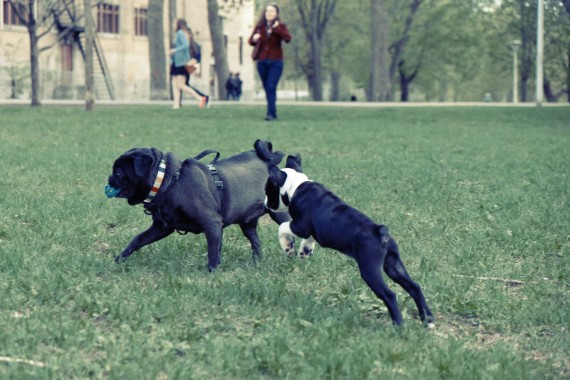Dog hydrotherapy: an overview
What is hydrotherapy?
 If your dog has suffered a recent injury or you are looking for a way to improve their general fitness, it is likely that your vet will recommend a course of hydrotherapy. But what does hydrotherapy actually involve?
If your dog has suffered a recent injury or you are looking for a way to improve their general fitness, it is likely that your vet will recommend a course of hydrotherapy. But what does hydrotherapy actually involve?
Hydrotherapy is the use of water to treat different conditions found within dogs, most notably arthritis but also a range of other complaints such as strains, sprains and joint damage. Typically, hydrotherapy involves performing different exercises and stretches for a set period of time within a heated pool. During the treatment your dog will be suspended in water meaning that no weight is placed on bones, joints, muscles and tendons whilst they exercise in the pool.
Hydrotherapy is a very popular choice amongst owners looking for a treatment to return their dog back to full fitness following an injury or illness. However, it has now been recognised that programmes also offer many more wide ranging benefits that are known to improve your dog’s quality of life.
Hydrotherapy as a concept is nothing new; in fact, it is common place amongst a wide range of human athletes where it is typically used as a method of gradual recovery from an injury. The non-weight bearing attributes of water allow for individuals to increase the range of movement in their joints and strengthen the soft tissue surrounding injured areas without putting unnecessary stress on joints and muscles which could further damage already weakened areas.
Although the application of this treatment has been more recent in dogs, it has quickly become recognised as a valuable way of treating animals too. In addition, more and more owners are now starting to take advantage of the all-round fitness and mental benefits offered to their dogs through this type of exercise.
Reasons for choosing hydrotherapy
Rehabilitation
 There are many different reasons why you might choose to use hydrotherapy for your dog. Rehabilitation from illness or injury is just one of these reasons, but it accounts for a lot of dogs taking part in these programmes. Often, dogs recovering from a recent injury are not able to perform more strenuous forms of exercise without risking causing further damage. Hydrotherapy allows for your dog to keep on exercising and stretching out their limbs whilst recovering from injuries, putting them on the right path to being able to enjoy the day to day activities they once enjoyed such as games and walks as their natural agility is gradually restored.
There are many different reasons why you might choose to use hydrotherapy for your dog. Rehabilitation from illness or injury is just one of these reasons, but it accounts for a lot of dogs taking part in these programmes. Often, dogs recovering from a recent injury are not able to perform more strenuous forms of exercise without risking causing further damage. Hydrotherapy allows for your dog to keep on exercising and stretching out their limbs whilst recovering from injuries, putting them on the right path to being able to enjoy the day to day activities they once enjoyed such as games and walks as their natural agility is gradually restored.
Fitness
Hydrotherapy programmes can also prove very effective for owners looking to improve the general fitness of their dog. The exercises carried out during sessions are particularly good for weight loss and cardiovascular fitness; maximising your dog’s ability to fully enjoy its life without being burdened with weight or fitness problems that might be preventing them from being the energetic dog they want to be.
Furthermore, hydrotherapy can also form an important part of training programmes designed for dogs that compete in agility competitions. Sessions can be designed for high intensity workouts and will help to maintain your dog at peak fitness in order to compete to the best of their best ability.
Fun
Any dog owner that has taken their pet to the beach will know the genuine excitement that swimming offers to dogs – they can’t get enough of it! Hydrotherapy is a great reward for dogs and can provide them with an excellent source of entertainment and stress relief. This reduces boredom and improves their mental well-being and morale.
Confidence
Every dog is different and for those dogs that are not as naturally confident in water, hydrotherapy offers a great chance to gain confidence in a safe and controlled environment, allowing them to gradually increase their swimming ability as the session’s progress.
Benefits of hydrotherapy
 Whilst many people might associate the words therapy and treatment with rehabilitation from injury, there are many more wide ranging benefits of the application of this treatment in dogs.
Whilst many people might associate the words therapy and treatment with rehabilitation from injury, there are many more wide ranging benefits of the application of this treatment in dogs.
Hydrotherapy has been proven to be a very effective tool in improving a dog’s quality of life. Injured or older dogs can often find their movement restricted and day to day tasks they once performed with ease can become a real challenge. This is particularly true of dogs suffering from arthritis or other age related problems. For dogs that find themselves in this category, hydrotherapy can be a great option for restoring their self-reliance. This type of exercise is likely to improve the range of motion in their joints, stimulate muscle growth and contribute to weight loss, all of which are likely to allow your dog to move more freely and give them back their quality of life.
Hydrotherapy treatment is a high intensity workout that is also good for cardiovascular fitness. Because of this, treatment can have a positive effect on a dog’s life span and reduce the chance of them suffering from weight or heart related problems in later life.
As we explain in our article on behavioural issues in dogs pain can be a major source of behavioural problems in dogs. If it is joint or muscle problems causing this pain, hydrotherapy can help. The heated pool in which a dog is suspended works to relax muscles and improve joint movement, acting to relieve pain for the dog during treatment. In the long term this therapy has been proven to eliminate this type of pain all together, not only making the dog much happier, but improving their all-round behaviour as well.
Whether your dog has picked up an injury during competition or perhaps starting to endure the common complaints associated with age, hydrotherapy can work to dramatically reduce the time they take to recover, as well as the chance of the injury resurfacing.
Finally, it is important that we don’t forget that, just like us, our dogs need a source of entertainment to break up their days as well. Swimming is great way to make sure your dog is getting the fun they need whilst also contributing to their overall health.
The process of hydrotherapy
Each hydrotherapy session at WitsEnd is led by a fully qualified veterinary physiotherapist, so you can rest assured that your pet is in safe hands. Most insurance companies will cover the cost of hydrotherapy treatment providing a vet has referred your dog, so it’s worth seeing if this treatment is included within your insurance.
Dogs come to us for a number of reasons and they all have differing levels of fitness, so before stepping into the pool it’s important that your dog is health checked. An initial routine that is too difficult for your dog can be harmful to them in the long run, so undertaking checks beforehand allows our physiotherapist to plan out sessions according to your dog’s current level of fitness and set targets for gradual improvement in the future.
Before entering the water, a life jacket will be fitted to your dog to provide buoyancy, but also to make it easy for the therapist to handle and stay in control on the dog whilst they are in the water.
 Dogs are then walked up a ramp at the side of the pool to give them easy access into the water. If your dog hasn’t been swimming before they might be a little hesitant at first; this is of course completely natural, but in a few minutes they should have gained their confidence and any nervousness will soon pass.
Dogs are then walked up a ramp at the side of the pool to give them easy access into the water. If your dog hasn’t been swimming before they might be a little hesitant at first; this is of course completely natural, but in a few minutes they should have gained their confidence and any nervousness will soon pass.
The pool has jets situated at the front of the pool which create a current for the dogs to swim against. The speed of this can be altered depending on the specific needs of your dog. For those dogs recovering from injuries, this is best set to a gentle current and for fitter dogs this can be set to a fast pace for a more intense work out.
If your dog is new to hydrotherapy then it’s best to start your sessions off short and aim to gradually build up the duration as your dog gets more confident in the water and muscle groups and joints start to strengthen.
At the end of each session your dog is showered, dried and receives a dog treat as a reward for their hard work and cooperation.
It’s important to mention that hydrotherapy is particularly effective when partnered with other treatments and vice versa. So we often recommend partnering this with other treatments to form an overall rehabilitation or fitness plan to give your dog the best chance of a speedy recovery. Physiotherapy is a great option; you can read some more information about this treatment in our guide here.
What WitsEnd can offer
At WitsEnd, we offer an all-encompassing service that not only ensures your dog is getting the most out of the treatment, but also makes sure that they feel comfortable and relaxed during each session they undertake. Our treatment includes:
- A fully qualified and experienced physiotherapist to lead each session
- A non-slip ramp to aid your dog getting in and out of the pool
- Heated pool set at 27°c that acts to relax muscles and joints during each session
- Jets that provide a current for your dog to swim against, adjustable to meet the individual requirements of your dog
- Washing and drying facilities for after the session
- Fully sanitised pool to keep it clean
- Individual programmes tailored to suit your dog
 Our team of hydrotherapy specialists is led by Dr Shahad Mohammed (PhD), who is qualified in animal physiotherapy and physiology. Shahad overseas all the rehabilitation work done here at WitsEnd including hydrotherapy and undertakes any veterinary / physiotherapy liaison to ensure that your dog’s individual programme is appropriately tailored to their recovery and development needs.
Our team of hydrotherapy specialists is led by Dr Shahad Mohammed (PhD), who is qualified in animal physiotherapy and physiology. Shahad overseas all the rehabilitation work done here at WitsEnd including hydrotherapy and undertakes any veterinary / physiotherapy liaison to ensure that your dog’s individual programme is appropriately tailored to their recovery and development needs.
If you think your dog can benefit from hydrotherapy and are interested in finding out some more information, please do get in touch with one of our team on 0116 244 2455 or email us at [email protected]. We’ll be more than happy to talk through any questions that you might and to recommend the best action for you and your dog.